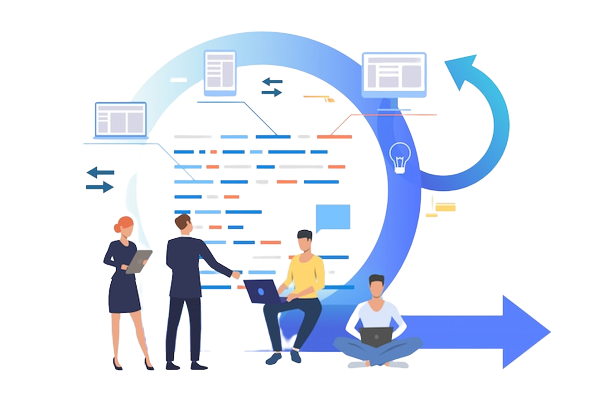In today’s dynamic business landscape, organizations of all sizes and across various industries face the complex challenge of managing projects efficiently. To overcome this hurdle, Project Management ERP (Enterprise Resource Planning) software emerges as a game-changer. By seamlessly integrating project management functionalities with comprehensive ERP features, this technology empowers businesses to streamline operations, optimize resource allocation, and achieve successful project outcomes. In this blog, we will delve into the world of Project Management ERP software, exploring its key benefits, features, and how it can revolutionize project management practices.

I. Understanding Project Management ERP Software
A. Definition and Scope:
Project Management: Explaining the core concept and its significance.
ERP: Defining ERP systems and their broader organizational impact.
Synergy: Highlighting how Project Management ERP combines both disciplines.
B. Key Components:
Project Planning and Scheduling: Discussing the ability to create project plans, assign tasks, and establish timelines.
Resource Management: Exploring features for efficient resource allocation and capacity planning.
Collaboration and Communication: Emphasizing tools that facilitate seamless collaboration and information sharing among team members.
Budgeting and Cost Control: Explaining financial modules that enable budget tracking and cost management.
Reporting and Analytics: Showcasing the significance of real-time reporting and data-driven insights for decision-making.
II. Benefits of Project Management ERP Software
A. Streamlined Project Lifecycle:
Efficient Planning and Execution: Highlighting the software’s ability to streamline project initiation, planning, execution, monitoring, and closure.
Enhanced Visibility and Transparency: Illustrating how real-time project data and analytics enable stakeholders to gain better insights into project progress and performance.
Risk Mitigation: Discussing the tools and features that help identify and manage risks throughout the project lifecycle.
B. Resource Optimization:
Improved Resource Allocation: Explaining how software facilitates optimal utilization of resources, reducing bottlenecks and optimizing productivity.
Team Collaboration and Communication: Emphasizing features that enhance team collaboration, coordination, and knowledge sharing.
Effective Time Management: Highlighting time-tracking capabilities to monitor and optimize project timelines.
C. Cost Management:
Accurate Budgeting and Forecasting: Demonstrating how the software enables accurate estimation, budgeting, and financial forecasting.
Cost Tracking and Control: Explaining modules that help track project expenses, control costs, and prevent budget overruns.
ROI Analysis: Discussing the software’s ability to evaluate project profitability and return on investment.
III. Key Features and Functionality
A. Project Planning and Scheduling:
Task Management and Assignment: Exploring tools for task creation, assignment, and tracking.
Gantt Charts and Critical Path Analysis: Discussing visual representations of project timelines and dependencies.
Milestone Tracking: Highlighting features to monitor project milestones and deliverables.
B. Resource Management:
Resource Allocation and Capacity Planning: Explaining how software optimizes resource allocation and ensures efficient capacity planning.
Resource Availability and Utilization: Discussing features that track resource availability and utilization rates.
C. Collaboration and Communication:
Document Sharing and Version Control: Illustrating how the software facilitates seamless document sharing and version control.
Team Dashboards and Portals: Showcasing collaborative platforms for real-time updates, discussions, and notifications.
Communication Channels: Discussing integrated communication tools such as chats, video conferencing, and email integration.
D. Reporting and Analytics:
Real-time Dashboards and KPIs: Explaining the significance of customizable dashboards and key performance indicators.
Data Visualization: Highlighting tools for visualizing project data and generating meaningful reports.
Predictive Analytics: Discussing advanced analytics capabilities that support data-driven decision-making.
IV. Selecting the Right Project Management ERP Software
A. Needs Assessment:
Identifying Project Management Requirements: Discussing the importance of understanding organizational project management needs.
Scalability and Flexibility: Highlighting the need for software that can grow and adapt to changing business requirements.
Integration: Emphasizing the importance of seamless integration with existing systems and software.
B. Vendor Evaluation:
Research and Shortlisting: Explaining the process of researching, shortlisting, and evaluating potential vendors.
Demo and Testing: Discussing the significance of requesting demos and conducting trials before making a final decision.
C. Implementation and Training:
Planning for Implementation: Highlighting the need for a well-defined implementation plan and timeline.
User Training and Adoption: Discussing the importance of training sessions to ensure smooth user adoption.
Conclusion:
Project Management ERP software represents a transformative solution that empowers organizations to streamline project management, optimize resource allocation, and achieve successful project outcomes. By integrating project management functionalities with comprehensive ERP features, businesses can enhance collaboration, improve visibility, and effectively manage project lifecycles. As organizations continue to embrace digital transformation, investing in the right Project Management ERP software becomes a crucial step toward maximizing project efficiency and driving long-term success.
